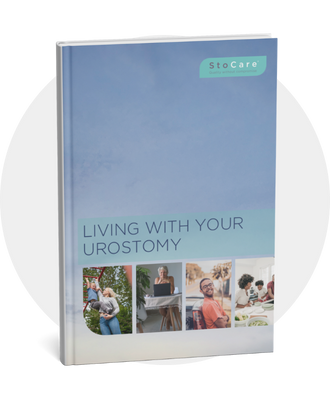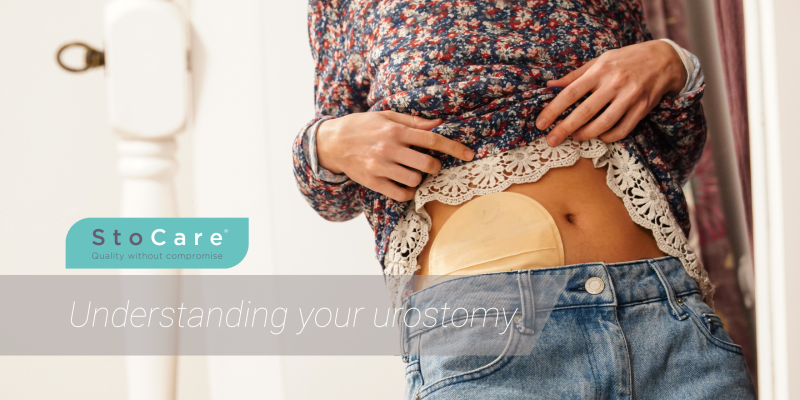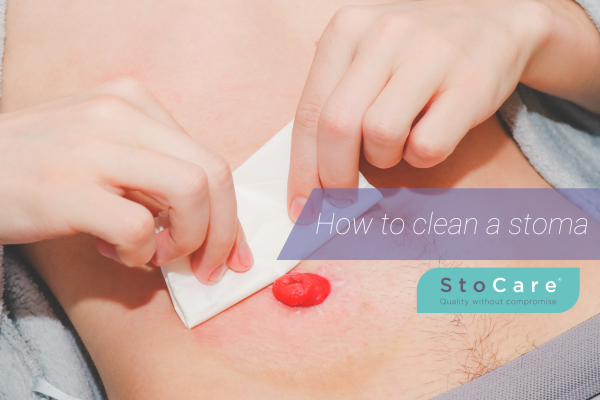This guide has been written to help you understand your urostomy. It will explain what a urostomy is and provide you with advice and support for before and after urostomy surgery.
It is normal to feel anxious before your surgery. But remember, there are thousands of people every year who are on the same journey. For a lot of people, a urostomy is a life-saving procedure. Every person is different and you will find that certain information is more relevant to you.
This information is available as a downloadable guide here, which you can print off or order a copy to be delivered to you.

What is a stoma?
The word ‘stoma’ is derived from the Greek, meaning ‘opening’ or ‘mouth’. Your stoma will look red, feel moist and be unique to you. No two stomas are the same. It may protrude from your abdomen or lay flat. It may also have dips, creases or folds depending on your body shape. Your stoma has no nerve supply so can feel no pain. Learn more: What is a stoma?
Anybody of any age can get a urostomy. They do not affect life expectancy and often improve quality of life.
What is a urostomy?
A urostomy is a surgical operation that diverts urine away from your bladder. Your bladder may have been removed if it is damaged or diseased and drainage of urine is no longer possible. A piece of your ileum (small intestine) or colon (large intestine) is separated from the rest of your bowel and used to create a conduit through an opening in your abdominal wall to form a stoma. Urine then leaves the body through your stoma. A urostomy is usually permanent and cannot be reversed.
After a urostomy, you will have no control over your urine flow. Urine generally drains constantly so you will need to wear a pouch.

Types of urostomy
- Ileal conduit – A short segment of the ileum is removed and used as a conduit to allow normal urine flow out of the body. The remaining ileum is reconnected and continues to work as normal. One end of the new conduit is sealed and the ureters joined to the conduit. The other end of the conduit is brought through the abdomen to the surface of the tummy to form a stoma.
- Colon conduit – This is very similar to an ileal conduit. However, a short segment of the colon, rather than the ileum, is used and brought through the abdominal surface to form a stoma.
Reasons for a urostomy
Why would you need a urostomy? Here are some common causes:
- Cancer
- Trauma
- Congenital abnormalities
Urostomies can be formed during a planned surgery or an emergency. Learn more: Why would you need a stoma?
Preparing for urostomy surgery
Your surgical team will provide you with information on all aspects of your surgery. You may have a few appointments prior to surgery including a preoperative assessment. During one of your meetings, your nurse will determine where the stoma will be placed so you can easily take care of it yourself. This is called ‘stoma siting’.
You will be provided with plenty of written information about the type of surgery and stoma you will have. You will also be given samples of supplies like stoma bags and medical adhesive remover to take home and familiarise yourself with. This is your chance to ask any questions or bring up any worries you might have.
Urostomy surgery recovery
When you wake up after the surgery, you will be wearing a transparent bag, so you and your nurse will be able to monitor your new stoma. To begin with, your nurse will drain your bag for you whilst you recover from surgery. They will assist you until you feel confident enough to empty it yourself. You will then start learning how to care for your own urostomy. It might help to have a family member or friend present so they know how to help you at home.
It is normal for your urostomy to appear bruised and swollen at first. It will produce mucus as well as urine. This may appear as pale threads in your urine or make your urine cloudy. You may see stents emerging from your urostomy. These protect the ureters that have been attached to the bowel, and will either fall out on their own or a nurse will remove them when they are happy that the join has fully healed.

It is normal to feel anxious, a little sore or tired after surgery. Remember to give your body time to recover both mentally and physically. It may take a while and you may experience a range of emotions, but there will be plenty of people there to support you.
Once discharged from the hospital, you may find it difficult to do simple things, such as showering and changing. Don’t worry, this will get easier over time and is completely normal. You should not feel the need to be bedridden all day. Getting up and walking around is very beneficial for your recovery as it will help with your blood circulation.
As expected with all surgeries, you may experience some slight pain and discomfort. If you feel the need to take some pain relief, follow the advice of your stoma care nurse who will advise you on how to manage any pain and provide support and guidance on the tablets you have been prescribed.
Follow the instructions given to you by your surgical team and stoma care nurse.
Can you drive with a urostomy?
Your urostomy should not impact your ability to drive. Your surgeon will advise you as to when you can safely return to driving. In some cases, you may need to report your surgery and treatments to your insurance company and seek advice.
Daily checklist
- Get up and walk around regularly.
- Take time to nap or rest when tired.
- Take your time returning to any strenuous tasks such as mowing the lawn or using a vacuum cleaner.
- Be aware of the increased risks when lifting heavy objects as this could cause a hernia.
- Take pain relief medication as recommended by a healthcare professional to ease discomfort.
How does a urostomy bag work?
A stoma bag or pouch is designed to be placed over your stoma in order to collect your urine. People with a urostomy use a drainable bag with a tap at the bottom so it can be easily drained, as many times a day as needed. It may have a twist tap, a bung or both. It is recommended that you empty it when it is about ⅓ to ½ full. You may find that you empty your pouch about as often as you used the bathroom prior to surgery.

How often you change your urostomy bag for a new one depends on personal preference. Wearing it for around three days is a good benchmark to aim for; this allows you to check the condition of your skin regularly, whilst protecting the skin from the affects of repeated adhesive removal. You should change it immediately if it has leaked. It is recommended that you use a medical adhesive remover to make changing your bag easier and protect your skin from damage.
You may use a one-piece or two-piece urostomy bag. Your stoma nurse will help you determine what type and size of bag you should wear.
During the night, you may choose to attach a piece of flexible tubing to the drain valve on your bag to collect urine into a bedside bag, allowing you an undisturbed nights sleep. Speak to your stoma nurse about the possibility of using a night drainage system.
Your stoma will be individual to you and will need to be measured so that the part of the appliance which goes against the skin (the flange or base plate) fits around it. This is called the ‘template’ and will help to prevent leakage and irritation to the skin surrounding your stoma. Initially you will be shown how to cut your stoma bag template. Once your stoma has settled in size (which can take a few weeks to months) you will be able to request pre-cut stoma bags.

Stoma care products are specialised products that are available by prescription through home delivery services and some pharmacies.
You will be provided with 2 weeks supply of products and follow up advice before you are discharged from hospital.
How to change a urostomy bag
Here is a step-by-step guide on how to change a urostomy bag:
- Wash your hands.
- Ensure you have everything you need to change your bag to hand.
- Ensure clothing is out of the way and you have easy access to your stoma.
- Use a medical adhesive remover to release the adhesive barrier (follow the manufacturer’s instructions).
- Remove the stoma bag from top to bottom by gently peeling back the flange.
- Once the stoma bag is removed, fold the adhesive section in half to seal it.
- Place the stoma bag into a disposal bag.
- Carefully wipe any fluid from the stoma and surrounding skin with a dry wipe.
- Do not apply any cream or lotions to your stoma unless advised to by your stoma nurse.
- Clean your skin with a wet wipe (ensure it is alcohol free).
- Dry your skin.
- Cut the flange of your new bag in order for it to accurately fit around your stoma.
- Use a medical barrier film spray or wipe to protect your skin from irritation (follow the manufacturer’s instructions).
- Apply any additional products as recommended by your stoma care nurse, such as a seal, flange extender, etc.
- Remove the backing film from the new bag.
- Position the flange around your stoma and gently smooth it upwards, avoiding any creases in the flange.
- Finally, place your hands on top of your stoma bag and hold for 30+ seconds to ensure your bag is well stuck to your skin.
Eventually, you will become comfortable with wearing and changing your stoma bag and it will become routine for you.

Taking care of your urostomy
Urostomy skincare
It is important to keep the skin around your stoma (peristomal skin) clean and healthy. Healthy skin provides a natural barrier against irritation and infection. Your peristomal skin should have an appearance similar to the surrounding abdominal skin. Here are some top tips to avoid skin damage:
- Stay hydrated.
- Change your bag as soon as possible if it has leaked.
- Remove hairs from around the stoma to prevent the adhesive on the bag from pulling on body hairs and causing pain/inflammation.
- Ensure that your stoma bag template is measured correctly.
- Clean the skin gently, avoid any irritants (perfumed soaps, lotions, wipes containing alcohol, etc.) and do not scrub.
- Ensure the skin is completely dry before replacing your pouch.
- Using a medical adhesive remover reduces the risk of skin damage when removing a bag, as can using a protective barrier film spray or wipe before applying a new bag.
If you notice any changes to your stoma or peristomal skin e.g. swelling, redness, lumps or a rash, do not hesitate to contact your stoma care nurse or GP, especially if the problem persists or gets worse.
Find out more: Peristomal skin protection and Stoma patients and MARSI
What to eat with a urostomy
After your surgery, you may feel that you have lost your appetite or that your diet has become restricted. Start by trying to eat small meals more frequently until you get your appetite back.
For most people, a urostomy will have little to no effect on their diet. You still need to eat a healthy, balanced diet which includes five portions of fruit and vegetables a day, carbohydrates in every meal and plenty of protein. It is very important that you drink plenty of fluids to protect from infections.
Find out more: Foods to eat with a stoma

Does a urostomy bag smell?
Odour tends to be a concern for patients who have undergone a urostomy. This should not be an issue as modern urostomy pouches are usually fitted with an odor barrier film. However, you may experience a strong smell when draining your pouch. Foods that can cause your urine to smell more include asparagus, fish, onions and garlic. Find out more: Stoma odour
How to stay hydrated with a urostomy
It is recommended that you drink 6-8 glasses of water per day. Remember to drink more if you lose fluids such as while sweating.
As long as it doesn’t interfere with any medication you’re taking, you should be fine to drink alcohol. Consult a medical professional if you are unsure. It will affect you just as it affects people without a stoma. Remember, alcohol has a diuretic effect and will make you pass more urine. This means you may have to drain your bag more regularly.
Caffeine is also fine to drink in moderation if you have had a urostomy. But again, it is a mild diuretic and may increase your need to urinate. So keep in mind, the more caffeine you drink, the more regularly you may have to drain your bag.
Can you shower with a urostomy bag?
After your urostomy, you should be able to shower or bathe normally. It is your choice as to whether you want to wear your stoma bag. Water is enough to keep your stoma clean. However, you may also use soap too.
If you decide to use soap to clean your stoma, opt for a perfume-free and non-moisturised soap. Don’t worry; water will not flow into your stoma. Soap should not irritate it in any way or cause any pain. Rinse soap off with water.
Water may disrupt the adhesion between your skin and stoma bag. Remember to always dry your peristomal skin well if you remove your bag or check your bag after showering or bathing to see if it is still securely in place.
What can you wear when you have a urostomy?
The main concern for most stoma patients is that their bag will be visible under their clothes and restrict their fashion choices. This is not the case. You will be able to return to your usual clothing once your swelling has settled. You can wear any clothes and dress to your personal preference. You do not have to wear ‘baggy clothes’ to disguise your bag. Today’s stoma bags are designed to be unrecognisable under clothes, so unless you tell someone you are wearing one, no one will ever know. You will be able to return to your usual clothing once your swelling has settled.

Swimwear
When it comes to swimwear, some people may feel self-conscious about their body image after surgery. You shouldn’t! There are plenty of companies that produce swimwear for ostomates. If you wear your own swimwear, thicker fabrics will help disguise your bag. For females, high-waisted bikinis don’t only look fabulous but can also cover your stoma. If you prefer, a tankini top will also hide your stoma. For males, swimming shorts are ideal as they tend to have a higher waistline and will not rub against your stoma. However, if a pair of Speedos are more to your taste, go ahead.
Read more in our guide to swimming with a stoma
Underwear
Many people with a stoma feel that they are unable to wear their usual style of underwear. Don’t let your stoma stop you from feeling sexy. You can still wear the same underwear as you did prior to surgery. However, if you find your old underwear uncomfortable, there are plenty of companies that sell specifically designed underwear for male and female patients.
Stoma clothing websites
Exercising with a urostomy
A urostomy should not affect your ability to exercise in the long term. You should be able to enjoy the same activities as before.
After your surgery, you may be visited by a physiotherapist who will give you plenty of advice and assist you with walking. It is important that you move around your home and try to take a short walk daily. However, don’t push yourself or do anything you don’t feel strong enough to do. Your age, fitness level prior to surgery, physical condition and surgery type will all become a factor in how quickly you can return to physical activity.

As time goes on and you begin to recover, you should be able to get back to a healthy lifestyle and engage in activities such as swimming, yoga, skiing, running and tennis (to name a few!). You can even partake in contact sports with a stoma – just like Colostomy UK’s rugby team! However, do not engage in any rough activities or try to lift weights until you are fully recovered.
Many patients may need a support belt to protect them from the development of a hernia or a stoma protector to prevent them from getting hit in the stoma. Speak to your stoma nurse for more information and advice. You can get them on prescription from the NHS or choose from a range available online, such as Mr Colitis Stoma.
For further tips and advice on returning to training after your surgery, read our guide to exercise with a stoma
What can you not do with a urostomy?
There is nothing you can’t do with a urostomy! You can live a full and normal life.
Can you go to work when you have a urostomy?
As with most surgeries, you will need time to recover. Your doctor will advise you as to when you should return to work. Your urostomy shouldn’t limit you at work, and you should be able to do everything you used to do. Make sure you take spare supplies to work with you, and you’ll be back to your routine in no time!
It’s up to you whether you tell your employer that you have a stoma. If you do tell them, they should be able to offer adjustments to make working more accessible for you, such as allowing you a phased return to work, flexible working arrangements and making toilets stoma-friendly.
Can you travel with a urostomy?
If you feel nervous about travelling after your surgery, don’t worry; it’s completely normal. You’ll gain your confidence back in time. But until then, maybe start with short-haul destinations.
Here are some quick tips for travelling with a stoma:
- Go through your bag change routine and make a list of everything you use.
- Calculate how many supplies you will need and pack plenty of extras, including different bag sizes.
- If flying, keep your stoma supplies in your hand luggage so it is not lost and you have them to hand should you need them.
- Carry your stoma supplies with you in a dedicated, easy-to-carry bag for quick and easy changes.
- You may want to download a travel certificate in the local language to explain your condition.
- For travelling in the UK, you can use a radar key to easily access disabled toilets.
Read more: Travelling with a stoma bag
Sex and relationships when you have a urostomy
A big worry for many people after surgery is that their new stoma will interfere with their intimate relationships. During recovery, you will be getting used to your new stoma and may not feel ready to engage in any sexual activity. Make sure you voice your worries to your loved one so they are able to understand. Sending them this article may help: Supporting a partner with a stoma
It is important that your partner understands that sexual activity will not harm you or your stoma. If you have undergone extensive surgery, you may experience pain. Ladies may also experience dryness after surgery. If this is the case, try using a lubricant or changing position to determine what is most comfortable and pleasurable for you and your partner. Sometimes, stoma surgery can affect the nerve endings and blood supply to the penis, resulting in erectile dysfunction. Speak to your stoma care nurse about this.

You and your partner will still be able to conceive after stoma surgery, unless you have undergone a radial cystectomy, in which case your fertility will be affected. In men, a radial cystectomy involves the removal of the bladder, prostate, upper urethra and seminal vesicles. In women, a radial cystectomy involves the removal of the bladder, uterus, ovaries, fallopian tubes, urethra and front wall of the vagina.
Speak to your oncologist if you have any fertility questions before starting any cancer treatments. However, if you don’t want to conceive you should speak to your doctor regarding contraception after surgery.
Body image after urostomy surgery
No two people in this world are the same, and we all perceive our own bodies differently. With today’s influx of social media, we also tend to compare our own bodies to other peoples. Having a stoma will change the physical state of your body, temporarily or permanently. This may alter the way you see yourself. Take all the time you need to adjust to your physical changes. Remember that you have potentially undergone lifesaving surgery and you are a survivor.
Do not let your stoma define or control you. You may feel emotional and down some days but just remember you’re not alone. Thousands of people have a urostomy every year and will be going through the same feelings as you.
Talk to the people around you about any body image worries you might have. Discussing your feelings with your close friends and family can help. You can also talk to your stoma care nurse or GP. They may be able to help you find a local stoma support group.
Taking medication with a urostomy
As with all medication, you should expect to experience possible side effects. Ensure you communicate these with your healthcare team.
Some medication can cause you to urinate more and empty your pouch more frequently. Your GP or pharmacist should let you know if this is likely to happen with any current or new medication you are taking.
People with urostomies are more susceptible to UTIs which may require treatment with antibiotics.
Urostomy problems
There are many common problems that people with a urostomy may encounter. We have briefly outlined some below and you can read in more detail in our full guide to urostomy problems.
Urinary tract infections (UTIs)
A urostomy puts you at greater risk of developing a UTI, which can lead to kidney problems. Bacteria can find its way into your urostomy, ureters or kidneys. Try to drink plenty of water everyday and empty your pouch regularly. Symptoms of a urinary tract infection include dark urine, strong smelling urine, increased frequency of urination, fever, back pain located around the kidneys and nausea. If you experience any of these symptoms, contact your GP as soon as possible.
Urine pH balance
Urine can either be an acidic or alkaline. Diet is a major factor that can determine the pH of a persons urine. After a urostomy, it is recommended that you try to keep your urine acidic as this can help prevent infection and urinary crystals. You can do this by consuming any fruit juice (particularly cranberry juice) or live yoghurt. Alcohol can increase the alkalinity of your urine.
Painful skin
Possibly the most common problem stoma patients encounter is sore skin. There are many causes, including urine on exposed skin, a poorly fitted bag, incorrect template sizing, skin reactions or sensitivity to any products and folliculitis (usually caused by shaving). If you are struggling with painful skin or leaks, talk to your stoma nurse who may suggest you try a stoma seal.

Bleeding or discharge from the urethra
If your urethra has been left in place and your bladder removed, you should speak to your doctor if you experience bleeding.
If your bladder has been left in place, you may experience discharge. This can become infected, in which case you’ll need to go on antibiotics. You may need regular bladder washouts. If the problem persists, women may be offered a small operation to make an opening from the bladder through the vagina to drain the fluid. Men may need to have the bladder removed.
Hernias
Stoma surgery can weaken the muscle that was cut, making it susceptible to a parastomal hernia. This is when a section of the intestine pushes through the muscle in the same area as the stoma and presses against the skin. This results in swelling around the stoma, which can get bigger over time. Parastomal hernias rarely cause complications. However, you should contact your stoma nurse if you suspect you have one, especially if you are experiencing pain. They will assess how serious it is and advise you how to manage it.
Read our full guide to parastomal hernias
Urostomy help and resources
Your stoma nurse is there to provide you with support and advise you on what products you should use to care for your stoma after surgery and beyond. Stoma care products are available on prescription through home delivery companies and some pharmacies. Certain services will be included when you are supplied with stoma products. These include pre-cut templates (once your stoma has settled), disposable bags, dry wipes and other products on request if required.

This information is available as a downloadable guide which you can save to your computer for future reference or print off at home. Click here to access it.
The Urostomy Association is a charity specifically set up to support people with a urostomy and they have lots of useful resources.
You may also want to explore Colostomy UK’s comprehensive information (for anyone with any type of stoma, not just colostomies), including a 24-hour stoma helpline.
If you are a medical professional and are interested in finding out more about how StoCare products can help your patients or requesting a repeat sample order, please email info@rhodespharma.co.uk.
This information is for guidance and does not replace advice given by your healthcare professional.



